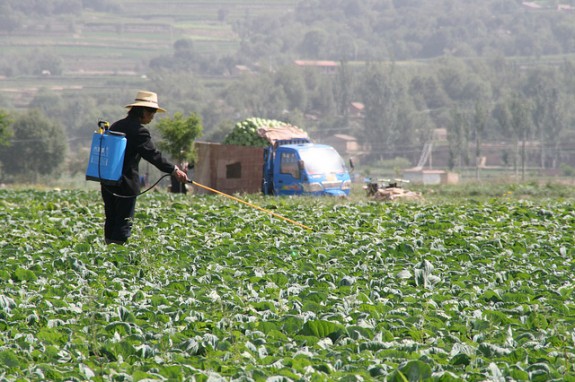Pesticides May Be Harmful to Animals Even at “Safe” Levels
Even when used at low concentrations, some pesticides can still cause unintended consequences

A Chinese farm worker sprays pesticides. Photo: IFPRI-Images
“All things are poison, and nothing is without poison: the dose alone makes a thing not poison.” The wisdom of Paracelsus, a 16th-century physician and alchemist, has formed the backbone of modern toxicology. There is a safe dose of radiation, and you can be poisoned by water. Some substances, like medicine, can be incredibly helpful at low levels but deadly at high ones. A modern toxicologist’s job is to find this line, and it’s a government’s job to put limits on exposure levels to keep everything safe.
For some compounds, however, the balance between safe and deadly may not be possible. The European Union seems to believe this is the case for one set of pesticides, the so-called neonicotinoids. The EU has recently banned their use. Writing for Nature, Sharon Oosthoek says that when it comes to certain pesticides, including these now-banned neonicotinoids, we may have missed the mark—at least in Europe and Australia.
Citing two recent studies, Oosthoek says that even when pesticides like neonicotinoids are used at a level that is deemed “safe,” there may still be deadly effects on local wildlife. Looking at streams in Germany, France and Australia, scientists found that “there were up to 42% fewer species in highly contaminated than in uncontaminated streams in Europe. Highly contaminated streams in Australia showed a decrease in the number of invertebrate families by up to 27% when contrasted with uncontaminated streams.” Pesticides can have outsized effects on some species, while others endure them just fine. And year-after-year applications can cause the pesticides to build up in the environment, making them deadly after a few years even if the amount sprayed each year is within guidelines. It’s not clear whether such strong losses are the case everywhere, but they were for the studied streams.
As Paracelsus taught us, there is a safe level for everything—even pesticides. The trick is finding the right balance such that we can still derive their benefits without the unintended consequences.
More from Smithsonian.com:
Another Downside to Your Classic Green Lawn
Crazy Lies Haters Threw at Rachel Carson
/https://tf-cmsv2-smithsonianmag-media.s3.amazonaws.com/accounts/headshot/smartnews-colin-schultz-240.jpg)
/https://tf-cmsv2-smithsonianmag-media.s3.amazonaws.com/accounts/headshot/smartnews-colin-schultz-240.jpg)